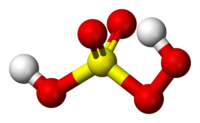Peroxymonosulfuric acid

| |
| Names | |
|---|---|
| IUPAC name
(Dioxidanido)hydroxidodioxidosulfur
| |
| Other names
Caro's acid
Hydroxy hydrogen sulfate Peroxomonosulfuric acid Peroxomonosulphuric acid Peroxymonosulphuric acid | |
| Properties | |
| H2SO5 | |
| Molar mass | 114.078 g/mol |
| Appearance | Colorless dense liquid (solution) White crystals (pure) |
| Density | 2.239 g/cm3 (pure) 1.7-1.8 g/cm3 (solution) |
| Melting point | 45 °C (113 °F; 318 K) |
| Boiling point | Decomposes |
| Miscible | |
| Solubility | Reacts violently with many organic solvents |
| Vapor pressure | ~0 mmHg |
| Hazards | |
| Safety data sheet | Solvay (<40%) |
| Flash point | Non-flammable |
| Related compounds | |
| Related compounds
|
Sulfuric acid Peroxydisulfuric acid Potassium peroxymonosulfate |
| Except where otherwise noted, data are given for materials in their standard state (at 25 °C [77 °F], 100 kPa). | |
| Infobox references | |
Peroxymonosulfuric acid, also known as persulfuric acid or Caro's acid, a strongly oxidizing acid with the formula H2SO5 first described by Heinrich Caro in 1898. It is prepared by reacting concentrated sulfuric acid (93-98%) with concentrated hydrogen peroxide (30-70% strength).
It is not usually encountered in pure form, but is used diluted with sulfuric acid, often with some hydrogen peroxide, in which form it is sometimes popularly known as "piranha solution" [1].
Caro's acid is used in industrial organic syntheses (e.g. oxidation of ketones to lactones or esters), it is used extensively for disinfecting and cleaning (e.g. metals, silicon wafers), and has been applied industrially as an oxidizing acidic leaching solution for the extraction of uranium from ore.[2]
Its salts have wide variety of industrial uses. The potassium salt, potassium peroxymonosulfate, is sold under the name Oxone for treating swimming pools.
Contents
Properties
Chemical
Caro's acid is among the strongest oxidizers known. It is unstable and is generally prepared within a few days of use. It is highly explosive, especially in mixtures with organic matter.
Physical
Caro's acid solutions are clear, colorless and are very viscous and have a oily consistency. The density is in the range 1.7 - 1.8 grams per milliliter.
Preparation
For laboratory use, small quantities of Caro's acid may be prepared by slowly adding H2O2 to concentrated sulfuric acid contained in a inert container e.g., glass, surrounded by an ice bath. The heat of dilution of the sulfuric acid causes strong heating, which makes the acid more unstable, so temperature control is essential. In addition, pouring other liquids into concentrated sulfuric acid can release caustic aerosols into the air that can damage skin and clothing. The process results in a mixture of Caro's acid, H2SO4, H2O2 and water, the ratios depending on the strength of the reagents, and their proportion. Prepared in this way, the Caro's acid can be stored under refrigeration for several days.
Purer Caro's acid can be obtained by reacting very concentrated hydrogen peroxide with chlorosulfuric acid:
- H2O2 + ClSO2OH ⇌ H2SO5 + HCl
However, as the acid is unstable, it will rapidly degrade and become diluted.
Caro's acid also may be prepared by adding sulfuric acid to aqueous slurries of sodium, ammonium or potassium persulfate.
This chemical is a byproduct, sometimes, of the production of potassium and ammonium persulfates, as shown by The Manufacture of Chemicals by Electrolysis[3].
Projects
According to Laboratory Methods of Organic Chemistry, by Gatterman (1937), p. 179: "Aromatic nitroso-compounds can also be obtained by oxidation of primary amines, but only one oxidising agent is known with which, the process can satisfactorily be carried out." This reagent is Caro's acid.
- Make acid piranha solution
Handling
Safety
Extremely corrosive. Highly irritating to skin, eyes, mucous membranes.
Can be dangerously unstable. If brought into contact with ethers and ketones it can create explosive and unstable peroxides. Description of explosion at Brown University: J. O. Edwards, Chem. Eng. News 33, 3336 (1955). Explosion at Sun Oil, ibid. 38, 59 (Nov. 21, 1960).
Storage
Caro's acid should not be stored, as there is a serious risk of explosion.
Disposal
Must be neutralized before disposal. Sodium or potassium carbonate or bicarbonate dissolved in a large amount of water can be used to neutralize it. A suspension of calcium carbonate can also be used.
See also
References
- Chiang John S. U.S. Patent 4,049,786 "Process of Preparing Peroxymonosulfate" Sept 20, 1977
- ↑ http://sciencemadness.wikia.com/wiki/Piranha_solution
- ↑ http://inis.iaea.org/search/search.aspx?orig_q=RN:16033702
- ↑ http://library.sciencemadness.org/library/books/the_manufacture_of_chemicals_by_electrolysis.pdf